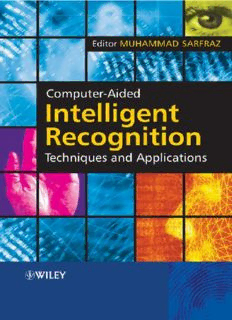Table Of ContentCOMPUTER-AIDED
INTELLIGENT
RECOGNITION
TECHNIQUES AND
APPLICATIONS
Edited by
Muhammad Sarfraz
KingFahdUniversityofPetroleumandMinerals,KingdomofSaudiArabia
COMPUTER-AIDED
INTELLIGENT
RECOGNITION
TECHNIQUES AND
APPLICATIONS
COMPUTER-AIDED
INTELLIGENT
RECOGNITION
TECHNIQUES AND
APPLICATIONS
Edited by
Muhammad Sarfraz
KingFahdUniversityofPetroleumandMinerals,KingdomofSaudiArabia
Copyright©2005 JohnWiley&SonsLtd,TheAtrium,SouthernGate,Chichester,
WestSussexPO198SQ,England
Telephone (+44)1243779777
Email(forordersandcustomerserviceenquiries):[email protected]
VisitourHomePageonwww.wiley.com
AllRightsReserved.Nopartofthispublicationmaybereproduced,storedinaretrievalsystemor
transmittedinanyformorbyanymeans,electronic,mechanical,photocopying,recording,
scanningorotherwise,exceptunderthetermsoftheCopyright,DesignsandPatentsAct1988or
underthetermsofalicenceissuedbytheCopyrightLicensingAgencyLtd,90TottenhamCourt
Road,LondonW1T4LP,UK,withoutthepermissioninwritingofthePublisher.Requeststothe
PublishershouldbeaddressedtothePermissionsDepartment,JohnWiley&SonsLtd,TheAtrium,
SouthernGate,Chichester,WestSussexPO198SQ,England,[email protected],
orfaxedto(cid:1)+44(cid:2)1243770620.
Designationsusedbycompaniestodistinguishtheirproductsareoftenclaimedastrademarks.
Allbrandnamesandproductnamesusedinthisbookaretradenames,servicemarks,trademarksor
registeredtrademarksoftheirrespectiveowners.ThePublisherisnotassociatedwithany
productorvendormentionedinthisbook.
Thispublicationisdesignedtoprovideaccurateandauthoritativeinformationinregardtothesubject
mattercovered.ItissoldontheunderstandingthatthePublisherisnotengagedinrendering
professionalservices.Ifprofessionaladviceorotherexpertassistanceisrequired,theservicesofa
competentprofessionalshouldbesought.
OtherWileyEditorialOffices
JohnWiley&SonsInc.,111RiverStreet,Hoboken,NJ07030,USA
Jossey-Bass,989MarketStreet,SanFrancisco,CA94103-1741,USA
Wiley-VCHVerlagGmbH,Boschstr.12,D-69469Weinheim,Germany
JohnWiley&SonsAustraliaLtd,33ParkRoad,Milton,Queensland4064,Australia
JohnWiley&Sons(Asia)PteLtd,2ClementiLoop#02-01,JinXingDistripark,Singapore129809
JohnWiley&SonsCanadaLtd,22WorcesterRoad,Etobicoke,Ontario,CanadaM9W1L1
Wileyalsopublishesitsbooksinavarietyofelectronicformats.Somecontentthatappears
inprintmaynotbeavailableinelectronicbooks.
LibraryofCongressCataloging-in-PublicationData
Sarfraz,Muhammad.
Computer-aidedintelligentrecognitiontechniquesandapplications/MuhammadSarfraz.
p. cm.
IncludesbibliographicalreferencesandIndex.
ISBN-13978-0-470-09414-3(cloth)
ISBN-100-470-09414-1(cloth)
1. Logiccircuits—Computer-aideddesign. 2. Patternperception. I. Title.
TK7868.L6S2572005
006.3—dc22
2004030987
BritishLibraryCataloguinginPublicationData
AcataloguerecordforthisbookisavailablefromtheBritishLibrary
ISBN-13978-0-470-09414-3(HB)
ISBN-100-470-09414-1(HB)
Typesetin9/11ptTimesbyIntegraSoftwareServicesPvt.Ltd,Pondicherry,India
PrintedandboundinGreatBritainbyAntonyRoweLtd,Chippenham,Wiltshire
Thisbookisprintedonacid-freepaperresponsiblymanufacturedfromsustainableforestry
inwhichatleasttwotreesareplantedforeachoneusedforpaperproduction.
Contents
Preface xvii
ListofContributors xix
1. OnOfflineArabicCharacterRecognition 1
MuhammadSarfraz,AbdulmalekZidouriandSyedNazimNawaz
(KingdomofSaudiArabia)
1. Introduction 1
2. StructureoftheProposedOCRSystem 4
3. Preprocessing 6
4. Segmentation 7
4.1 LineSegmentationandZoning 8
4.2 WordSegmentation 8
4.3 SegmentationofWordsintoIndividualCharacters 9
5. FeatureExtraction 10
6. RecognitionStrategy 11
6.1 RecognitionUsingtheSyntacticApproach 12
6.2 RecognitionUsingtheNeuralNetworkApproach 13
7. ExperimentalResultsandAnalysis 15
7.1 SystemTraining 15
7.2 ExperimentalSet-up 15
7.3 ResultsAchieved 15
8. Conclusion 17
Acknowledgement 17
References 17
2. LicensePlateRecognitionSystem:SaudiArabianCase 19
MuhammadSarfrazandMohammedJameelAhmed(KingdomofSaudiArabia)
1. Introduction 19
2. StructureofaTypicalLPRSystem 20
3. ImageAcquisition 21
4. LicensePlateExtraction 21
4.1 VerticalEdgeDetection 23
4.2 Filtering 23
4.3 VerticalEdgeMatching 24
4.4 BlacktoWhiteRatioandPlateExtraction 26
5. LicensePlateSegmentation 26
vi Contents
6. CharacterRecognition 26
6.1 Normalization 26
6.2 TemplateMatching 27
7. ExperimentalAnalysisandResults 27
8. Conclusion 32
References 32
3. AlgorithmsforExtractingTextualCharactersinColorVideo 33
EdwardK.WongandMinyaChen(USA)
1. Introduction 33
2. PriorandRelatedWork 34
3. OurNewTextExtractionAlgorithm 35
3.1 Step1:IdentifyPotentialTextLineSegments 36
3.2 Step2:TextBlockDetection 38
3.3 Step3:TextBlockFiltering 38
3.4 Step4:BoundaryAdjustments 38
3.5 Step5:BicolorClustering 38
3.6 Step6:ArtifactFiltering 39
3.7 Step7:ContourSmoothing 39
4. ExperimentalResultsandPerformance 40
5. UsingMultiframeEdgeInformationtoImprovePrecision 47
5.1 Step3(b):TextBlockFilteringBasedonMultiframeEdgeStrength 47
6. DiscussionandConcludingRemarks 47
References 48
4. SeparationofHandwrittenTouchingDigits:AMultiagentsApproach 51
AshrafElnagar(UAE)andRedaAl-Hajj(Canada)
1. Introduction 51
2. PreviousWork 52
3. DigitizingandProcessing 56
4. SegmentationAlgorithm 56
4.1 ExtractionofFeaturePoints 56
4.2 TheEmployedAgents 57
5. ExperimentalResults 61
6. ConclusionsandFutureWork 65
References 65
5. Prototype-basedHandwritingRecognitionUsingShapeandExecutionPrototypes 67
MiguelL.Bote-Lorenzo,EduardoGómez-SánchezandYannisA.Dimitriadis(Spain)
1. Introduction 67
2. AHandwritingGenerationProcessModel 68
3. TheFirstStagesoftheHandwritingRecognitionSystem 70
3.1 CharacterSegmentation 70
3.2 FeatureExtraction 71
4. TheExecutionofthePrototypeExtractionMethod 73
4.1 GroupingTrainingSamples 74
4.2 RefinementofthePrototypes 75
4.3 ExperimentalEvaluationofthePrototypeExtractionMethod 76
5. Prototype-basedClassification 82
5.1 ThePrototype-basedClassifierArchitecture 82
5.2 ExperimentalEvaluationofthePrototypeInitialization 83
Contents vii
5.3 PrototypePruningtoIncreaseKnowledgeCondensation 84
5.4 DiscussionandComparisontoRelatedWork 85
6. Conclusions 87
Acknowledgement 87
References 87
6. LogoDetectioninDocumentImageswithComplexBackgrounds 89
TuanD.PhamandJinsongYang(Australia)
1. Introduction 89
2. DetectionofPotentialLogos 90
3. VerificationofPotentialLogos 91
3.1 FeatureExtractionbyGeostatistics 91
3.2 NeuralNetwork-basedClassifier 93
4. ExperimentalResults 93
5. Conclusions 97
References 97
7. AnIntelligentOnlineSignatureVerificationSystem 99
BinLi(China)andDavidZhang(HongKong)
1. Introduction 99
1.1 ProcessandSystem 100
1.2 TheEvaluationofanOnlineSignatureVerificationSystem 101
2. LiteratureOverview 102
2.1 ConventionalMathematicalApproaches 102
2.2 DynamicProgrammingApproach 104
2.3 HiddenMarkovModel-BasedMethods 105
2.4 TheArtificialNeuralNetworksApproach 106
2.5 SignatureVerificationProductMarketSurvey 106
3. ATypicalOnlineSignatureVerificationSystem 107
3.1 DataAcquisition 107
3.2 FeatureExtraction 110
3.3 FeatureMatching 111
3.4 Verification 112
4. ProposedOnlineSignatureVerificationApplications 113
4.1 SystemPasswordAuthentication 113
4.2 InternetE-commerceApplication 114
5. Conclusions 116
References 116
8. HybridFingerprintRecognitionusingMinutiaeandShape 119
AskerBazen,RaymondVeldhuisandSabihGerez(TheNetherlands)
1. Introduction 119
2. ElasticDeformations 120
3. ElasticMinutiaeMatching 122
3.1 LocalMinutiaeMatching 122
3.2 GlobalMinutiaeMatching 123
4. ShapeMatching 126
5. Results 126
6. Conclusions 129
Acknowledgement 129
References 129
viii Contents
9. PersonalAuthenticationUsingtheFusionofMultiplePalm-printFeatures 131
Chin-ChuanHan(Taiwan,R.O.C.)
1. Introduction 131
2. Preprocessing 133
2.1 Step1:ImageThresholding 134
2.2 Step2:BorderTracing 134
2.3 Step3:Wavelet-basedSegmentation 135
2.4 Step4:RegionofInterest(ROI)Generation 135
3. FeatureExtraction 135
4. EnrollmentandVerificationProcesses 136
4.1 MultitemplateMatchingApproach 136
4.2 MultimodalAuthenticationwithPBF-basedFusion 137
4.3 AdaptiveThresholding 139
5. ExperimentalResults 140
5.1 ExperimentalEnvironment 140
5.2 VerificationUsingaTemplateMatchingAlgorithm 140
5.3 VerificationUsingPBF-basedFusion 141
6. Conclusions 142
References 142
10. IntelligentIrisRecognitionUsingNeuralNetworks 145
MuhammadSarfraz,MohamedDeriche,MuhammadMoinuddin
andSyedSaadAzharAli(KingdomofSaudiArabia)
1. Introduction 145
2. LiteratureReview 147
3. SomeGroundbreakingTechniques 148
3.1 Daugman’sMethod 149
3.2 Boles’sMethod 150
3.3 MethodofDyadicWaveletTransformZeroCrossing 151
4. NeuralNetworks 154
4.1 MultilayerFeed-forwardNeuralNetworks(MFNNs) 154
4.2 RadialBasisFunctionNeuralNetworks(RBFNNs) 156
5. ProposedMethod 158
5.1 LocalizingtheIris 158
5.2 FindingtheContour 159
5.3 FeatureExtraction 159
5.4 IrisPatternRecognition 162
6. ExperimentalResults 162
6.1 ResultsforanMFNN 162
6.2 ResultsforanRBFNN 162
7. GraphicUserInterface(GUI) 164
8. ConcludingRemarks 166
References 166
11. Pose-invariantFaceRecognitionUsingSubspaceTechniques 169
MohamedDericheandMohammedAleemuddin(KingdomofSaudiArabia)
1. Introduction 169
1.1 Background 170
1.2 TheProblemofPose 171
Description:Intelligent recognition methods have recently proven to be indispensable in a variety of modern industries, including computer vision, robotics, medical imaging, visualization and the media. Furthermore, they play a critical role in the traditional fields such as character recognition, natural langu

